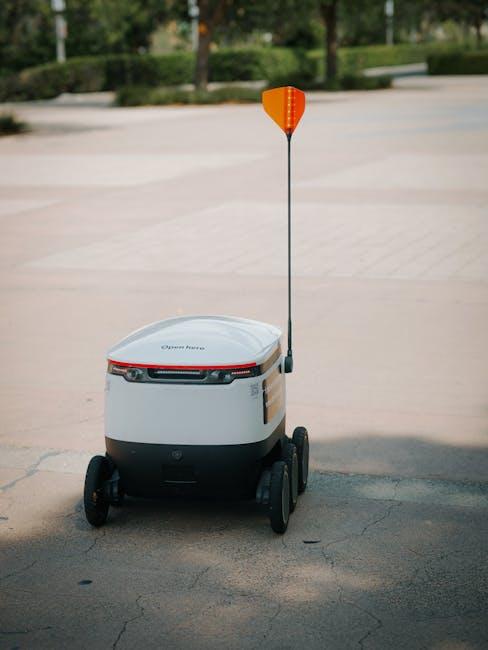In the rhythm of daily life, few experiences unite us as universally as the commute. Whether it’s the early morning drive through city streets or the evening trek home, the unpredictability of traffic can turn routine journeys into frustrating ordeals. Enter artificial intelligence-a transformative force quietly reshaping how we understand and navigate the flow of vehicles. By harnessing vast data streams and sophisticated algorithms, AI is emerging as a powerful tool to predict traffic patterns, optimize routes, and ultimately make commuting smarter and less stressful. This article explores the evolving role of AI in forecasting our daily travels, illuminating how technology is steering us toward smoother roads ahead.
Understanding the Role of AI in Modern Traffic Prediction

Artificial Intelligence has revolutionized how we understand and manage urban mobility. By analyzing vast volumes of real-time data-from GPS devices, traffic cameras, social media feeds, and even weather reports-AI systems can predict congestion patterns with unprecedented accuracy. These insights empower city planners and commuters alike to make smarter decisions, whether rerouting in response to an unexpected accident or adjusting traffic signal timings to optimize flow. The combination of machine learning models and big data enables a dynamic approach that evolves alongside the city’s infrastructure and daily rhythms.
The core strengths of AI in traffic prediction lie in its ability to process diverse data sources rapidly and its adaptability to changing conditions. Key advantages include:
- Real-time updates: Instantaneous analysis of traffic anomalies allows for proactive rather than reactive management.
- Pattern recognition: Identification of recurrent bottlenecks and seasonal variations enhances long-term planning.
- Scalability: AI models seamlessly extend from small neighborhoods to entire metropolitan regions.
| AI Technique | Primary Benefit | Example Use Case |
|---|---|---|
| Machine Learning | Predicting traffic volumes | Commuter route optimization |
| Deep Learning | Image and video analysis | Accident detection via CCTV |
| Natural Language Processing | Analyzing social media and reports | Incident forecasting |
Key Technologies Powering AI-Driven Commute Forecasting

At the heart of modern commute forecasting lie several cutting-edge technologies that transform raw data into actionable insights. Machine learning algorithms are pivotal, analyzing vast datasets from GPS signals, traffic cameras, and historical traffic patterns to predict congestion before it happens. Complementing this are real-time data streams sourced from connected vehicles and smart infrastructure, enabling models to adapt instantly to unexpected incidents like accidents or roadworks. Together, these technologies empower systems to provide dynamic, minute-by-minute updates that enhance commuter decision-making.
Another cornerstone is the use of geospatial analytics, which interpret spatial data to map out optimal routes and highlight bottlenecks with remarkable precision. This is often enriched by natural language processing (NLP) capabilities that gather and synthesize traffic reports, social media updates, and driver feedback, painting a holistic picture of road conditions. Below is a brief overview of these technologies and their unique contributions:
| Technology | Role in Commute Forecasting |
|---|---|
| Machine Learning | Predicts traffic trends by learning from historical patterns |
| Real-Time Data Integration | Updates forecasts instantly with live traffic information |
| Geospatial Analytics | Analyzes location-based data for route optimization |
| Natural Language Processing | Processes unstructured data for comprehensive road condition insights |
Challenges and Limitations in AI Traffic Modeling

Despite the promising advances in AI-driven traffic prediction, several hurdles remain that complicate its seamless integration into everyday commute management. One primary issue is the dependence on high-quality, real-time data. Traffic conditions fluctuate dynamically, influenced by unpredictable events such as accidents, roadworks, and weather conditions. AI models often struggle to adapt quickly to such anomalies without continuous data updates and robust handling of outliers. Furthermore, privacy concerns around the collection of location data restrict the volume and granularity of information accessible, which in turn affects model accuracy.
Computational complexity also presents a significant constraint. Complex AI models, especially those based on deep learning, demand substantial processing power and extensive training time, which may not always be feasible for real-time traffic applications across large urban areas. Additionally, integrating diverse data sources-from sensors to social media updates-poses a challenge in harmonizing inconsistencies and biases. This leads to another set of difficulties, including:
- Data sparsity in less-monitored regions
- Model generalizability across different cities
- Interpretability of AI-generated predictions for practical decision-making
| Challenge | Impact | Possible Solution |
|---|---|---|
| Inconsistent Data Quality | Reduced prediction accuracy | Data pre-processing & validation |
| Real-time Processing | Delayed traffic updates | Edge computing & optimized algorithms |
| Privacy Constraints | Limited data access | Federated learning approaches |
Practical Recommendations for Implementing AI in Urban Mobility Systems

To effectively harness AI for improving commute and traffic predictions, stakeholders should prioritize data integration from multiple sources. Combining real-time traffic sensors, public transit data, weather reports, and social event calendars enables AI models to produce more accurate and context-aware forecasts. Additionally, investing in scalable cloud infrastructure ensures that systems remain responsive during peak usage times, such as rush hours or special events. By continuously updating datasets and machine learning algorithms, urban planners can adapt strategies dynamically, minimizing congestion and enhancing commuter experience.
Implementation efforts should also focus on user-centric design and transparency. Providing commuters with clear, actionable insights, like alternative routes or estimated arrival times, encourages trust and adoption. Moreover, cities must cultivate partnerships between public agencies, private tech providers, and local communities to establish standardized data-sharing protocols. Below is a sample timeline outlining key phases for rolling out an AI-driven traffic prediction system:
| Phase | Duration | Key Activity |
|---|---|---|
| Discovery & Assessment | 2 months | Data inventory & stakeholder mapping |
| Development & Testing | 4 months | Model training & pilot deployment |
| Launch & Monitoring | 3 months | User feedback & system refinement |
- Continuous data validation to maintain accuracy
- Privacy-preserving techniques to protect user information
- Adaptive algorithms to respond to changing urban dynamics
Wrapping Up
As the daily rhythm of our journeys intertwines ever more closely with the pulses of technology, AI emerges not just as a tool, but as a quiet co-pilot-anticipating traffic snarls, smoothing commutes, and reshaping our relationship with the road ahead. While the algorithms hum beneath the surface, their impact carries us toward a future where travel is less about frustration and more about flow. In the end, AI’s promise to predict and ease our travels invites us all to imagine a world where every trip starts on time, every route finds its rhythm, and the daily commute transforms from a chore into a seamless experience.













